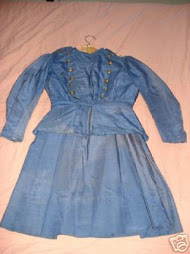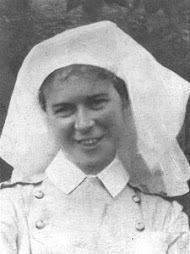Thursday, January 30, 2014
Remembering Minnie Follette
"Unflinchingly and calmly, as steady and collected as if on parade, without a complaint or a single sign of emotion, our fourteen devoted nursing sisters faced the terrible ordeal of certain death--only a matter of minutes--as our lifeboat neared that mad whirlpool of waters where all human power was helpless."
(Extract from Sergeant A. Knight's story of the destruction of the Llandovery Castle.)
Today I’m writing about Minnie Asenalte Follette—an experienced, heroic nurse who was one of the 14 Canadian women who died at sea while on hospital duty aboard HMS Llandovery Castle.As I have mentioned in previous posts, the nurses on this ship were all women who had seen long service overseas. Several had enlisted with the 1st Canadian Contingent and begun their service in September 1914.
Minnie Asenalte Follette was born November 11, 1884 in Nova Scotia. She was the daughter of Oscar and Lydia Follette (nee Hatfield.) Oscar was a master mariner. Her parents were Methodists.
Minnie followed in her mother’s footsteps, training at the Victoria General Hospital School of Nursing, the first nursing school in Nova Scotia. Applicants had to be 20 years or older, provide a recommendation from a clergyman, and after the probationary period were paid the princely sum of $9 per month for their first year and $11 for their second. According to the synopsis of their program, “The instruction will include the general care of the sick, the managing of helpless patients in bed, changing bed and body linen, giving baths, keeping patients warm or cool, preventing and dressing bed sores, bandaging, applying of fomentations, poultices and minor dressings, the preparing and serving of food, the feeding of helpless patients and those who refuse food, the administering of enemata and use of the catheter, the observation of symptoms of delirium, stupor, shock, etc.” (from the VGHSN Annual Report 1907-1908, Mount Saint Vincent Archives). It was a limited curriculum for a woman who would one day treat the terrible wounds of the First World War. Follette graduated from the school in 1909. She was 5’5” and weighed 125 pounds, with blue eyes and brown hair.
By 1911, Follette was working at No. 2 Army Medical Corps Military Hospital in Halifax. In 1912, she embarked on a special course of study in military nursing. After Follette’s death, her friend and fellow nurse Blanche Grant wrote to Follette’s parents and described how the two women served at the Typhoid Emergency Hospital at Christmas 1914 during the epidemic that was gripping Halifax at the time. Grant reported that Follette sent her many letters during the latter’s service in France.
Follette enlisted on September 24, 1914 and sailed with the First Canadian Contingent on October 3, 1914. After her arrival in Britain, she was assigned to No. 2 Canadian General Hospital on Salisbury Plain. In early 1915, she was transferred to 1st Canadian Casualty Clearing Station in France. She would serve there until March 1916. By that time, Minnie’s health had broken down from stress and the heavy load of nursing. In early April, she was admitted to No. 14 General Hospital in Wimereaux and eventually found herself in London, recovering from what the Military Medical Board called “nervous exhaustion.” She was ordered to take two months of sick leave. The board reported: “This nursing sister is suffering from the strain of constant duty with the 1st CEF for part of the time in a Casualty Clearing Station. She requires a considerable time of leave for complete recovery.” Follette would take two months to relax, recover, and play the tourist in Britain.
In May 1917, Follette was assigned to No. 9 Canadian Stationary Hospital in Bramshott. She served there for two months before being assigned to hospital ship duty with HMS Letitia. On August 1, at Chebucto Bay, Halifax, the ship sank. All aboard, including Follette, were saved from the wreck. After the incident, Follette was given 17 days furlough. Upon her return to Britain, she was assigned to No. 16 Canadian General Hospital, at Orpington, Kent. The earlier wreck does not seem to have fazed this daughter of a master mariner. At the end of March 1918, she volunteered to transfer to the hospital ship Llandovery Castle. According to an undated news clipping, “Miss Follette made a number of trips on the Llandovery Castle and was very popular with the men who returned on that ship, they speaking in glowing terms in the faithful way in which she attended to her duties.”
On June 27, 1918, the HMS Llandovery Castle, clearly marked as a hospital ship, was sunk by a German U-Boat which later rammed all lifeboats. Here is the record of what happened to the 14 nurses aboard:
Sergt. A. Knight, the non-commissioned officer of the C.A.M.C., who took charge of life-boat No. 5, into which the fourteen nurses were placed.
"Our boat," said Sergt. Knight, "was quickly loaded and lowered to the surface of the water. Then the crew of eight men and myself faced the difficulty of getting free from the ropes holding us to the ship's side. I broke two axes trying to cut ourselves away, but was unsuccessful.
"With the forward motion and choppy sea the boat all the time was pounding against the ship's side. To save the boat we tried to keep ourselves away by using the oars, and soon every one of the latter were broken.
"Finally the ropes became loose at the top and we commenced to drift away. We were carried towards the stern of the ship, when suddenly the poop-deck seemed to break away and sink. The suction drew us quickly into the vacuum, the boat tipped over sideways, and every occupant went under.
"I estimate we were together in the boat about eight minutes. In that whole time I did not hear a complaint or murmur from one of the sisters. There was not a cry for help or any outward evidence of fear. In the entire time I overheard only one remark when the matron, Nursing Sister M.M. Fraser, turned to me as we drifted helplessly towards the stern of the ship and asked:--
"Sergeant, do you think there is any hope for us?"
"I replied, 'No,' seeing myself our helplessness without oars and the sinking condition of the stern of the ship.
" A few seconds later we were drawn into the whirlpool of the submerged afterdeck, and the last I saw of the nursing sisters was as they were thrown over the side of the boat. All were wearing life-belts, and of the fourteen two were in their nightdress, the others in uniform.
"It was," concluded Sergt. Knight, "doubtful if any of them came to the surface again, although I myself sank and came up three times, finally clinging to a piece of wreckage and being eventually picked up by the captain's boat."
Nurse Minnie Follette was one of those nurses. Her name is inscribed on the Halifax Memorial. (With thanks to Bruce MacDonald for his help.To see Bruce's blog: http://guysboroughgreatwarveterans.blogspot.ca/)
Subscribe to:
Post Comments (Atom)






















No comments:
Post a Comment